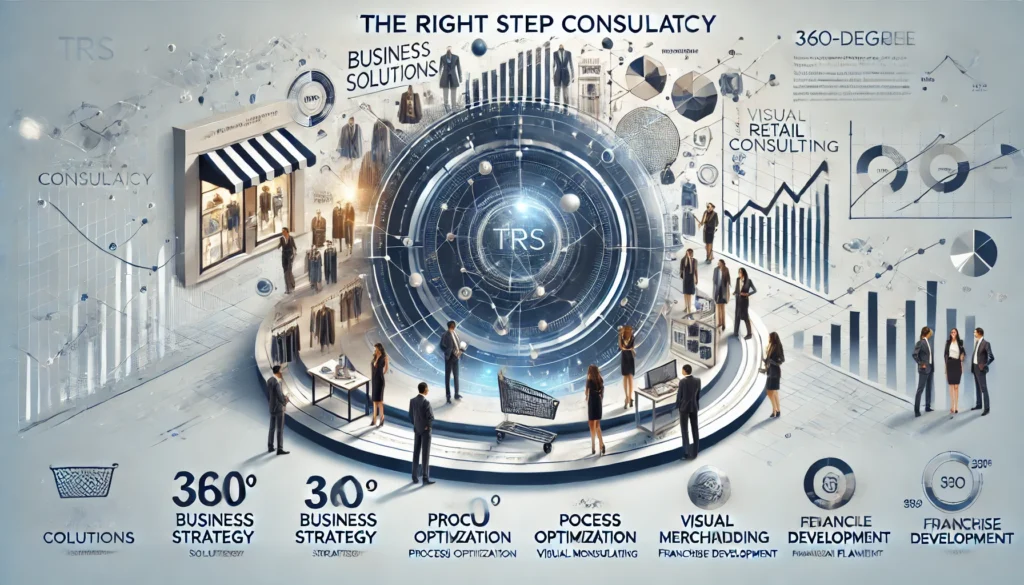Retail Business Consulting - Expert Guidance for a successful launch
Retail Business Challenges from a Management Perspective
Retail businesses today operate in a landscape filled with complexities—ranging from inventory accuracy and store-level efficiency to customer retention and supply chain agility. While the fundamentals of retail remain consistent, execution now requires sharper insights, faster adaptation, and more holistic strategies. Without the support of an experienced retail consulting firm or a seasoned retail industry consultant, businesses risk inefficiencies and missed opportunities.
Whether you’re aiming to optimize operations, enhance customer experience, implement SOPs, or expand through franchising, TRS provides comprehensive retail business consulting services backed by real-world expertise.
Looking to improve operations, strengthen processes, or launch a new retail or franchise venture?
Let TRS—your trusted business growth consultant, retail store consultant, and franchise growth consultant—help you build a tailored strategy for sustainable and measurable success.
Transform Your Retail & E-Commerce Strategy Today
How TRS Supports as Business Growth Strategy Consultant for Retail
True business growth requires more than good planning; it demands disciplined execution every single day. As an experienced business growth strategy consultant and retail business consultant, TRS helps retail and franchise companies scale by establishing strong systems, optimizing resources, and creating processes that can be replicated across multiple locations.
With TRS managing daily operational challenges:
Business owners can focus on growth and expansion.
Resources are utilized efficiently, reducing operational costs.
Proven workflows can be automated, increasing output.
Expansion into new locations becomes simpler and more systematic
This consistency is achieved through well-structured business processes—primarily delivered through professional SOPs. TRS offers end-to-end sop development services and is recognized among the leading sop writing consultants, enabling companies to streamline every operational layer.
Transform Your Retail & E-Commerce Strategy Today
Supply Chain Assessment & Retail SOP Development
As a leading retail consulting firm and trusted retail industry consultant, TRS begins by assessing the client’s supply chain structure to identify operational gaps, inefficiencies, and performance challenges. Once new goals and benchmarks are set, our team evaluates existing workflows to determine what must be improved for stronger execution and scalable growth—supporting both retail operations and franchise expansion consultant requirements.
Using these insights, TRS delivers structured sop development services that align with updated supply chain objectives, enabling smoother implementation across procurement, logistics, and day-to-day retail operations.
As expert sop writing consultants and experienced retail business consultant partners, we develop SOPs for essential inventory functions, including:
Supplier selection & onboarding
Purchase, order, and reorder management
Demand forecasting
Quality control
Returns and exchanges
Receiving & storage workflows
Inventory documentation & audits
These SOPs bring consistency, accuracy, and control across all retail and franchise locations—strengthening operational performance and supporting long-term expansion goals. With deep experience in Franchise Model Development, TRS also assists brands looking to scale through structured franchise systems as reliable franchise development consultants.
Transform Your Retail & E-Commerce Strategy Today
Retail Business Franchise Consulting Expertise
Beyond retail operations, TRS is also a leading franchise expansion consultant, offering expertise in Franchise Model Development, franchise partner selection, franchise SOP creation, and franchise agreements. Recognized as one of the trusted franchise development consultants and top-tier Franchise Development Consultant teams, TRS supports brands in building scalable and profitable franchise networks.
TRS also provides professional business plan writing services, acting as a reliable business plan writing consultant for retail and franchise businesses seeking investor-ready documentation
Transform Your Retail & E-Commerce Strategy Today
SOPs for Assortment Management & Resupply
The task of timely delivery of commodities is known as replenishment. Assortment decides which items should be on the shelves or in stock. In retail establishments, both must work hand in hand.
For example, certain products may need to stay on shelves due to seasonal demand. These merchandising changes must be understood by the replenishment team to ensure timely release. Meanwhile, products with consistent demand must also be restocked regularly.
A typical retail assortment includes hundreds of products and variants across several brands. Keeping replenishment and assortment aligned is essential to ensuring the right products are always available at the right time.
TRS understands the complexities of modern retail. Our SOPs ensure replenishment and assortment work seamlessly to maintain the right product mix as per schedule. Even with automation, these processes must be clearly documented through well-defined SOPs.
Transform Your Retail & E-Commerce Strategy Today

Typical Retail Store Operating Procedures
TRS offers a detailed set of standard operating procedures covering nearly every aspect of a retail store’s daily functions. These SOPs support both new businesses setting up strong processes from the start and existing retailers aiming to improve or reorganize operations.
They’re also ideal for businesses undergoing changes like rebranding, expansion, or opening new locations. TRS ensures operations remain smooth, consistent, and easy to scale as your business grows.
Looking to set up or streamline your retail operations?
Transform Your Retail & E-Commerce Strategy Today

Re-engineering the Distribution Center Layout and SOPs
Retail stores that offer eCommerce services—sometimes called dark stores—often need to run their own distribution centers. While distribution centers are mostly linked to online shopping, many retailers rely on them to manage stock and deliveries more efficiently.
Over time, the layout of a distribution center may need to change to boost capacity and improve efficiency. But layout changes impact more than just space—they affect how people and machines move, how inventory flows, and how daily tasks are carried out. For example, shifting the packaging area alters not only worker movement but also the steps before and after that task.
That’s where TRS comes in. We help you develop new standard operating procedures (SOPs) that align with your updated layout and workflows. Our aim is to ensure a smooth transition and help your teams adapt quickly. We also review and update related processes and recommend necessary software changes to fully support the new setup.
Transform Your Retail & E-Commerce Strategy Today

Consultation on Retail Business Plans
TRS’s business plan consulting services focus on both the financial and commercial aspects of retail operations. As a trusted business plan writing consultant, our experts conduct thorough research and offer clear, data-backed insights to help clients understand the financial landscape of their business. The goal is to simplify complex numbers and make strategic planning, decision-making, and business growth more straightforward for our clients, positioning TRS as a reliable provider of business plan writing services.
Consulting for Retail Business Franchisees
When it comes to franchise growth consultant, TRS offers complete support—from creating a strong expansion strategy to managing audits and control systems. We help develop detailed franchise business models, draft business plans, choose the right franchise partners, prepare legal agreements, and design clear SOPs through franchise operations manuals.
Transform Your Retail & E-Commerce Strategy Today

Strategy for Retail Store Layout
Planning and choosing a retail store consultant involves a number of considerations. Some of these are fundamental, such as mobility restrictions, safety and security, etc. Only a select few can afford the other set, which is a little more opulent. This covers things like interior design, branding, and aesthetics. According to TRS, combining the two realms is difficult, but it is where magic’s power rests. Getting the help of luxury retail experts to create an efficient store layout that reaches the pinnacles of luxury is harmless. These professionals from retail consulting organizations assist in quickly identifying and putting the best solutions into practice.
Design and Operations SOPs for Retail Warehouse Layouts
Back-end activities are the primary emphasis of warehouse layout design if the layout of a retail store prioritizes the customer experience. A good warehouse design must offer maximum holding capacity due to the following reasons: adherence to quality control, safety, and security standards; ease of mobility of people and merchandise; and error-free execution of warehousing, inventory management, and order fulfillment operations. Just as important to the effectiveness of a layout design is operations planning. If a procedure cannot be easily completed in a layout, it is not a fit arrangement. As seasoned retail industry consultants, TRS provides expert assistance in incorporating SOPs for inventory and warehouse operations together with the most appropriate warehouse layout design.
How TRS Assists in Seizing Possibilities for Online Retail
With over a decade of experience, TRS is a retail and eCommerce business consulting firm. Additionally, TRS is one of the few retail consulting firms with a consistent yet expanding global footprint. TRS’s area of competence encompasses the complexities of both retail and eCommerce, having experience and knowledge in both fields. Because of this, TRS’s retail store consultants are able to spot possibilities that span across channels and offer knowledgeable solutions.
Consulting for Omnichannel
In omnichannel consulting, TRS helps identify areas where omnichannel strategy can be applied followed up with the requisite strategies, planning, and operational roadmap. TRS maintains that an omnichannel strategy must be applied thoughtfully and strategically. Omnichannel strategy is meant to serve as a bridge over problems which neither retail nor eCommerce alone can cover. For example, if a furniture brand provides a mobile app to help customers visualise how a furniture product would look in their homes, it makes it easier for customers to process their buying decisions. Or a mobile phone brand having authorised sales and service centres would be much more convincing to customers.
How Establishing a New Retail Business is Aided by TRS
Retail Strategy Consulting :
When it comes to retail consulting, TRS assists in developing the whole spectrum of functional strategies that enable new companies to be completely equipped from the inside out in terms of each company function, both separately and as a whole. CX, operations, technology, digital marketing, infrastructure and layout, supply chain and logistics, and personnel/HR are a few of the key areas of strategic importance in the retail industry.
Consulting for Retail Pricing Strategies:
In recent years, retail pricing methods have become increasingly dynamic. Retailers must be alert in addition to the conventional base variables in order to react to the shifting dynamics of the market environment, particularly those coming from rivals (both online and offline). With over a decade of experience as a retail consultant, TRS has helped numerous companies refine their pricing strategies. The goal of TRS is straightforward: to assist clients in determining the appropriate pricing while keeping in mind their larger financial and business objectives.
Creating a Business Plan:
TRS’s business plan consulting services are focused on getting the financial and commercial angles right from the word go. Other elements of business planning like business model development and operations planning are dealt with as separate services. In business plan consulting services, TRS addresses a comprehensive coverage of matters of financial and commercial significance.
Use SOPs to Create a Store Management System
A store management system (SMS) is a collection of rules, guidelines, and technological tools used to oversee retail business operations. As seasoned retail operations consultants, TRS assists in implementing ready-to-use, tried-and-true SMS solutions. These solutions are adapted because every retail firm has different needs. Developing and implementing SOPs is one of TRS’s primary skills. One area where retail businesses struggle the most is making sure that the stated plans and policies controlling operations are followed. Making a strategy or a policy is simple, but making sure that people in charge of operations follow it is the true challenge. SOPs are a great tool for solving this issue. SOPs are also crucial since the quality of the processes and operations is what determines how well a deployed technology supports operations planning.
Just Consulting for E-Commerce
In eCommerce consulting, TRS offers an extensive range of services starting from market research to order fulfilment SOPs. Here, TRS caters to two sets of clients – startups and existing eCommerce brands and businesses.
For startups, TRS helps build a business foundation based on insightful and actionable market research, razor-sharp business strategies and planning, best-fit technologies, and high-ROI digital marketing and branding campaigns. Retail businesses intending to shift gears to eCommerce are also covered here.
For existing eCommerce brands and businesses, the requirements are different. These are businesses that are usually for growth and expansion. There may be a vision for the same but the challenge is the ‘how’ of it. This is where TRS chips in with the right set of solutions covering eCommerce CX, eCommerce omnichannel, eCommerce operational excellence, and guidance for eCommerce process automation.
Retail Business Franchise Expansion
In franchise growth consulting, we help from the formulation of a sound franchise expansion strategy to the details of franchise audit and control. As a leading retail consulting firm, TRS lays down the entire roadmap of franchise implementation. In addition to these extreme ends, other important areas covered by TRS as a franchise expansion consultant include franchise business model development, the formulation of a franchise business plan, assistance in franchise partner selection, development of franchise operations manuals (franchise SOPs), and franchise agreements – positioning TRS as a trusted Franchise Development Consultant with strong expertise in Franchise Model Development.

How may a retail business be started?
It is crucial to establish a roadmap in the form of plans and strategies before beginning the ground-level execution. The following highlights some of the most important business planning topics when launching a retail company:
1. Validation of business ideas
2. Market research
3. Development of business models
4. The use of omnichannel marketing
5. Analysis of store locations
6. Planning a store layout
7. Logistics, storage, and inventory control
8. Planning for operations
9. Technology plan (automation and IT)
10. HR and manpower planning tasks
11. Commercial and financial forecasts and planning
12. CX and CRM
13. Online advertising
The aforementioned domains frequently intersect. Dealing with what occurs first and then categorizing it as this or that is a sensible strategy. If a point does not fit into any of the aforementioned categories, new sections may be created based on their significance.
How may retail establishments be successfully managed?
The simple answer is putting in place measures that make sure the store runs as it is required to. Before formulating and delivering retail consulting services, TRS maintains that a basic question every entrepreneur should ask themselves is whether their business is running as intended or desired or not. If the answer is negative, they need to find out why and implement the changes. Here are some useful practices to better manage a retail business:
1. Always express gratitude to clients and show them that you value their visits.
2. Maintain your staff’s motivation and professionalism (e.g., training, dress codes, documentation, competitive pay, feedback, PMS, etc.).
3. Try to improve those weak areas by using client feedback, especially from target segments.
4. Take inventory reporting seriously
5. Implement strict quality control procedures
6. Constantly monitor the company environment and market trends and make necessary adjustments
7. Maintain the opulence and glitz while letting the branding take center stage.
8. Take part in mystery audits.
Maintain a human touch while operating as a process-driven business to avoid becoming a mechanical setup.
How can retail inventory be managed?
For excellent retail inventory management, the following criteria must be upheld:
1. Accuracy and reliability of demand projections
2. Scheduling and planning for purchases
3. SOPs for all procedures and activities related to inventory management
4. Implementing strict and reliable QA and QC procedures throughout the supply chain
5. Putting the specified storing conditions into practice in warehouses and FCs
6. Periodical and daily reporting
7. Regularly conducting inventory audits (physical, digital, and paper)
8. Establishing guidelines and procedures for accurately measuring and tracking stock
9. Ensuring the safe, easy, and traceable entry and leave of inventory from warehouses
10. Utilizing software for inventory management
11. Continue to collaborate professionally with supply chain partners
Reduce the rate of shrinkage and keep holding and carrying expenses under control.
How can a multi-store inventory management system be set up?
The following elements must be appropriately included and integrated into a multi-store inventory management system, both centrally and at the store level as appropriate:
1. Management of products
2. Management of purchases and replenishments (including supply chain, retailers, and warehouses)
3. Monitoring and reporting on inventory
4. Store and channel sales management
5. Inventory transfer between stores
6. Centralized control and analytics
7. Performance monitoring for QA and QC
How might activities in retail warehouses be made more efficient?
Among the most important tactics for optimizing retail warehouse operations are:
1. Optimizing the architecture of the warehouse layout (e.g., creating space for extra inventory)
2. Scheduling and preparing for purchases
3. Changing personnel lists to better accommodate busy times and times of year
4. Eliminating redundant processes from all SOPs for warehouse operations
5. Using industrial automation tools to transfer inventory physically
6. Using technological tools that facilitate and expedite labor (e.g. barcode scanners)
7. Cutting back on the amount of manual authorizations
Moving resources and assets closer to the scene of action
Why establish a layout strategy for your retail store?
Planning and strategy determine what is achieved on the ground. A strategy is an endeavor to achieve the intended results. Customer experience is one of the main goals of retail store layout design. If they are not satisfied with the layout, all else fails. Other considerations include operating procedures, safety and security, and space optimization. Nonetheless, the foundation upon which these components function as management limitations is the customer experience.
Essential elements of a retail business plan
The term “retail business strategy” is broad. Therefore, the focus will be focused on highlighting some of the key areas/goals where having a solid strategy is crucial for the retail industry.
1. Brand differentiation and value propositions
2. The value chain
3. CRM, customer experience, and customer segmentation
4. Retailing
5. Cost
6. Channel and distribution
7. Sources of income
8. Optimization of costs
9. Operations
10. Technology
11. Human Resources/Staffing
12. Finance
13. Online advertising
Essential elements of retail supply chain management
The movement of commodities from point of origin to point of destination is mapped out and defined by a supply chain. Supply chain management in the context of a retail company refers to the planning, operations, and strategies that control the movement of inventory from producers and distributors to retailers and final consumers. Supply chain management, for instance, includes overseeing the last delivery and installation of goods for an electronics retailer. To put it another way, the availability of the appropriate goods at the appropriate time or location will be hampered if there are flaws in quality control procedures (inventory management) or if lengthier transportation routes are selected. Alternatively, selecting the incorrect technology and tools will have comparable effects.





